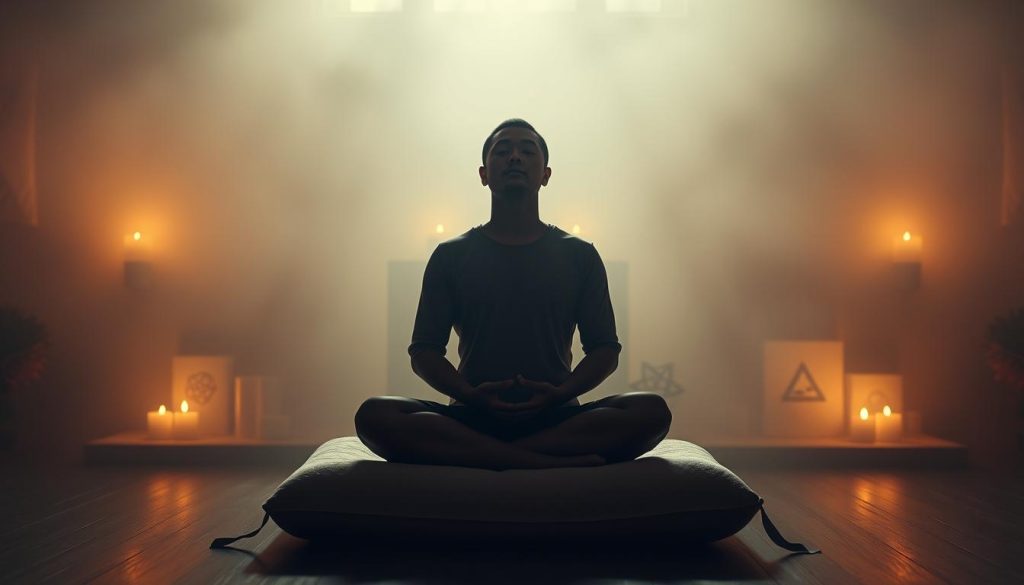Welcome. We’re here to gently map two paths that help the mind relax and change. This intro sets a clear, kind comparison so we can choose with curiosity and calm.
One route is guided and goal-oriented; the other trains steady attention and awareness. Both deepen relaxation and boost wellness.
We’ll explore how hypnosis aligns conscious aims with subconscious receptivity and how meditation builds focus, mindfulness, and emotional resilience. Expect practical use cases like sleep, pain, habits, and daily clarity.
Think of this as a friendly lab. We mix science and experience, quick relaxation skills and long-term brain change, and give gentle next steps so you can try what fits your schedule and style.
Mindfulness in the present: why this comparison matters now
Our fast-paced world asks us to steady the mind. Small tools can pull us back to the present moment. Ancient roots meet modern science as meditation becomes a practical habit for many.
Both guided sessions and simple daily practices ease stress and trigger the body’s rest response. That reduction in tension can help sleep, focus, and calmer reactions.
We notice that some people want a therapist-led path; others like open, self-paced routines. Awareness skills are portable. You can use them on a lunch break or before bed.
This is about matching time and rhythm to life. Start with a few breaths or a short audio. The process is experimental, gentle, and practical. We invite curiosity, not perfection, as we test what helps us feel more at home in our bodies.
Defining the practices: hypnosis and meditation explained
We’ll outline two complementary routes that calm the nervous system and shape inner habits. One uses guided suggestion; the other trains steady attention. Both are practical, accessible, and gentle.

What guided suggestion is
Guided suggestion is a focused state where the mind becomes more open to helpful prompts. A practitioner often guides this process to address specific goals like sleep, pain, or habit change.
While aware and in control, we may tap the subconscious mind to reframe responses and accelerate relaxation. Studies show this method can teach quick relaxation responses with consistent practice.
What attention training is
Attention training strengthens awareness through simple methods—mindfulness meditation, body scans, breath-focus, loving-kindness, or repeating a mantra.
This practice invites us to notice thoughts without judgment, build concentration, and steady emotions over time. Neural shifts have been documented after weeks of regular practice.
Shared ground
Both paths slow breathing, lower tension, and cultivate a calmer nervous tone. They overlap in brain-wave patterns and in the practical benefits people seek—better sleep, less stress, and steadier energy.
We invite curiosity: some days we want soothing guidance; other days we prefer quiet space to watch the mind. Combining approaches can be a helpful experiment.
Key differences that shape outcomes
These two approaches shape outcomes by the aim they set and the state they invite. The difference often shows up fast when we pick a goal and measure results.
Goal and focus
Hypnosis leans toward targeted change. We set a clear aim and use tailored suggestions to shift habits like sleep, pain, or cravings.
Open awareness
Meditation favors open noticing. We train gentle attention to build calm and clarity over many sittings rather than chasing one specific outcome.
States of mind
The hypnotic state is a focused doorway to subconscious patterns. Meditation keeps us in witness mode — present and curious.
Guidance and time
A trained hypnotherapist or hypnotherapy session can personalize language and pace. That structure often brings quicker wins for pressing issues in fewer sessions.
Daily meditation is the long game. Over months, it widens resilience and steady attention. We can combine both: targeted guidance for urgent shifts, and a simple practice to keep gains steady.
What science and experience show about the mind-body connection
What we feel in the body echoes in the brain, and gentle practices can change that echo. Lab studies and clinic notes both point to measurable changes when we shift into calmer states.

Research shows that meditation activates the parasympathetic system. That can lower heart rate, blood pressure, and muscle tension. Two months of steady practice has even been linked to structural brain shifts (Hölzel, 2011).
Clinical work reports that hypnosis induces focused attention and can quickly teach a relaxation response, including with children (Anbar, 2021). People stay aware and in control; no one can be forced against their values.
Both paths cut markers of stress and help the brain–body system regulate. Meditation has a larger research base, while hypnosis shows strong clinical value for targeted changes like pain, sleep, and habits.
We honor both lived experience and measurable findings. The shared benefit is simple: reduced reactivity and more reliable calm. Try a short practice and notice how your mind and brain respond after a few weeks.
When to choose each: matching techniques to goals, time, and lifestyle
When goals and daily rhythms meet, we choose tools that match urgency and temperament.
Specific goals and issues
Hypnotherapy is often best for clear, pressing aims: natural pain relief, sleep improvement, weight loss, stopping habits, or boosting confidence.
Its guided stance can speed results for one-off problems and teach quick coping tools. If an immediate shift matters, targeted sessions can help.
General wellness
Meditation shines when we want steady buffers against stress and a stronger ability to focus. Regular practice builds emotional resilience and mind–body harmony.
Think of it as a daily tonic that lifts baseline calm and attention over weeks.
Time, discipline, and attention style
Ask how much time you have and what style suits a person: step-by-step guidance or open observing? Some prefer structure. Others like quiet space.
We suggest testing both for a month: use hypnotherapy for targeted wins and a short daily practice for lasting balance. See what changes in life and keep what works.
Hypnosis vs. Meditation in 2025: Which Works Best for You
We can tailor a guided pathway or pick gentle self-led routines that fit our day. Both paths offer clear ways to calm the nervous system and shift habits.

Personalized sessions and tailored language
A skilled hypnotherapist crafts metaphors and precise suggestions that match goals and subconscious patterns.
Those one-to-one sessions keep clients aware and in control while speeding targeted change.
Self-driven tools for daily regulation
Simple routines—body scan, breath focus, loving-kindness, or a short mantra—are repeatable and portable.
Use them between meetings, before sleep, or when stress rises. They steady attention and build gentle awareness.
Blending and a mini toolkit
We can mix guided tracks and solo work. A breath anchor often opens a focused state for suggestion-rich audio.
Build a mini tools kit: two guided audios and one silent timer. Swap what doesn’t click.
Try playfully: morning mantra, evening hypnosis meditation, and note small wins—deeper sleep, calmer pauses, clearer days.
How to get started today: simple pathways into each practice
Start small: clear intentions and tiny routines make change feel gentle and possible.
Beginning with guided suggestion
Clarify one outcome and research a licensed hypnotherapist who lists training and client focus. Set a cadence that fits your week—weekly or biweekly is common.
Expect to stay aware and in control during sessions. A friendly session arc looks like intake, induction, targeted suggestions, and integration.
Reinforce gains with brief daily listens, journaling key phrases, and gentle environmental cues. Apps also offer structured hypnotherapy tracks for home practice.
Beginning with breath and attention
Start with two to five minutes of breath awareness or a body scan. Build toward 10–20 minutes as time allows.
Try different techniques: brief mindfulness check-ins, loving-kindness phrases, or a focused breath anchor. Use timers or guided courses to stay consistent.
Pair both practices with daily rituals—after coffee or before sleep—and track sleep, mood, and cravings weekly to notice subtle shifts.
Bringing it together for better wellness in 2025
,
We can pair short daily practices with focused sessions to shape steady, practical wellness. Start with a brief mindfulness habit each morning. Add guided suggestion work when a clear change is needed.
This mix respects the subconscious mind and keeps clients in control. Use simple tools to track sleep, mood, and energy. Tune the plan after two weeks.
Over a long time, steady attention builds resilience and brain shifts. Targeted sessions bring quicker relief for specific issues. Together they create a flexible way to return to a calm state and gentle relaxation throughout the day.
